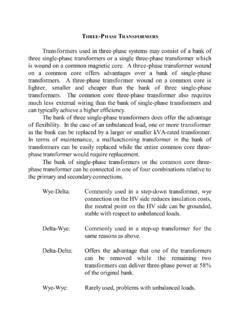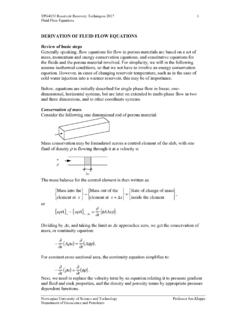Transcription of BALANCED THREE-PHASE CIRCUITS - Mississippi State …
1 BALANCED THREE-PHASE CIRCUITSThe voltages in the THREE-PHASE power system are produced by asynchronous generator (Chapter 4). In a BALANCED system, each of the threeinstantaneous voltages have equal amplitudes but are separated from theother voltages by a phase angle of 120. The three voltages (or phases ) areotypically labeled a, b and c. The common reference point for the threephase voltages is designated as the neutral connection and is labeled as n. We may define either a positive phase sequence (abc) or a negative phaseanbncnsequence (acb) as shown below. The three sources V, V and V aredesignated as the line-to-neutral voltages in the THREE-PHASE VOLTAGESAn alternative way of defining the voltages in a BALANCED three -phasesystem is to define the voltage differences between the phases .
2 Thesevoltages are designated as line-to-line voltages. The line-to-line voltagescan be expressed in terms of the line-to-neutral voltages by applyingKirchoff s voltage law to the generator circuit, which yieldsInserting the line-to-neutral voltages for a positive phase sequence into theline-to-line equations yieldsIf we compare the line-to-neutral voltages with the line-to-line voltages, wefind the following relationships,Line-to-neutral voltagesLine-to-line voltagesLine-to-line voltages in terms of line-to-neutral voltagesThe equations above show that the magnitudes of the line-to-line voltagesin a BALANCED THREE-PHASE system with a positive phase sequence are %&3times the corresponding line-to-neutral voltages and lead these voltages CONNECTIONSThe sources and loads in a THREE-PHASE system can each be connectedin either a wye (Y) or delta ()) configuration.
3 Note that the wyeconnections are line-to-neutral while the delta connections are line-to-linewith no neutral. Also note the convention on the node designations(lowercase letters at the source connections and uppercase letters at the loadconnections). Sources Loads Wye source Wye load Delta source Delta loadBALANCED WYE-WYE CONNECTIONThe BALANCED THREE-PHASE wye-wye connection is shown below. Notethat the line impedance for each of the individual phases in included in thecircuit. The line impedances are assumed to be equal for all three line currents (IaA, IbB and IcC) are designated according to thesource/load node naming convention. The source current, line current, andload current are all one in the same current for a given phase in a wye-wyeconnection.
4 Wye source Wye loadAssuming a positive phase sequence, the application of Kirchoff s voltagelaw around each phase giveswhere Ztotal is the total impedance in each phase and 2Z is the phase angleassociated with the total phase impedance. The preceding equations can besolved for the line CurrentsLine-to-neutral voltagesNote that the line current magnitudes are equal and each line current lagsthe respective line-to-neutral voltage by the impedance phase angle , the BALANCED voltages yield BALANCED currents. The phasor diagramfor the line currents and the line-to-neutral voltages is shown below. If welay the line-to-neutral voltage phasors end to end, they form a closedtriangle (the same property is true for the line currents).
5 The closed triangleshows that the sum of these phasors is fact that the line currents sum to zero in the BALANCED wye-wyeconnection shows that the neutral current In is zero in this BALANCED , the impedance of the neutral is immaterial to the performance of thecircuit under BALANCED conditions. However, any imbalance in the system(loads, line impedances, source variations, etc.) will produce a non-zeroneutral any BALANCED THREE-PHASE system ( BALANCED voltages, BALANCED lineand load impedances), the resulting currents are BALANCED . Thus, there isno real need to analyze all three phases . We may analyze one phase todetermine its current, and infer the currents in the other phases based on asimple BALANCED phase shift (120o phase difference between any two linecurrents).
6 This technique is known as the per phase (Per phase analysis)A wye-wye BALANCED THREE-PHASE system with a phase voltage of 120V-rms (positive phase sequence) has a line impedance of Zline= (1+j1) Sand load impedance of ZY = (20+j10) S. Determine the phasor line currents(IaA, IbB, IcC) and the phasor load voltages (VAN, VBN, VCN).Analyze the a-phase determine the b phase responses, subtract 120o from the angle of the aphase determine the c phase responses, subtract 240o (add 120o) to the angleof the a phase THREE-PHASE POWERIn a BALANCED wye-wye THREE-PHASE system, we have found that theline currents and load voltages are BALANCED (equal magnitudes, phaseangles at 120o intervals). Thus, the rms phasor line currents may be writtenin general form aswhere we have assumed a positive phase sequence.
7 The resulting phasorload voltages can be written in terms of the phasor line currents asThe corresponding instantaneous line currents and load voltages areThe total instantaneous power delivered to the THREE-PHASE load iswhere the three terms represent the instantaneous power in the individualloads associated with the three phases . Inserting the instantaneous loadvoltages and line currents givesThe cosine products in the equation above can be rewritten using thetrigonometric identity used in the single phase power derivation:The instantaneous power then becomesThe three double frequency terms in the instantaneous power expressionadd to zero according to the following trigonometric identity:The instantaneous power in the BALANCED THREE-PHASE load reduces to Note that the BALANCED THREE-PHASE load instantaneous power isconstant and equal to three times the average power in one phase.
8 Thetime-invariant characteristic of the THREE-PHASE instantaneous power is incontrast to that of a single-phase system where the instantaneous power wasshown to oscillate at twice the system frequency. The constant nature ofthe THREE-PHASE instantaneous power (smooth power delivery) is ofparticular importance in THREE-PHASE motors. The mechanical shaft torqueis constant and vibration is minimized. The concept of complex power can be extended to a BALANCED THREE-PHASE system by defining the THREE-PHASE complex power delivered to thewye load aswhere Vload and Iline are the load voltage and line current phasors for anindividual phase of the THREE-PHASE system with a wye-connected the voltage and current phasors into the complex three -phasepower equation givesThus, the apparent, real and reactive power components in a three -phasewye load areNote that the preceding equations are specialized for wye loads.
9 Amore general way of writing the complex power for any type of three -phaseload iswhere Wye loadDelta loadVloadLine-to-neutral voltage (VAN)Line-to-line voltage (VAB)IloadLine current (IaA)Load current (IAB)S3N = 3 VAN IaA*S3N = 3 VAB IAB*The concepts of power factor and the complex power triangle can alsobe extended to a BALANCED three phase power system without loss ofgenerality. The THREE-PHASE power factor is defined by the same single-phase equationsince the relative angle between the voltage and current is equal in all threephases of a BALANCED THREE-PHASE system. The THREE-PHASE complex powertriangle is identical to the single-phase power triangle with the apparent,real and reactive powers replaced by the corresponding THREE-PHASE CONNECTIONS INVOLVING DELTA SOURCES OR LOADSIn addition to the wye-wye THREE-PHASE connection, there are threeother possible configurations of wye and delta sources and ConnectionWye-Delta ConnectionDelta-Wye ConnectionThe most efficient way to handle THREE-PHASE CIRCUITS containing deltasources and/or loads is to transform all delta connections into Source TransformationGiven that a delta source is defined in terms of line-to-line voltages whilethe wye source is defined in terms of line-to-neutral voltages.
10 We can usethe previously determined relationship between line-to-line voltages andline-to-neutral voltages to perform the , line-to-neutral voltages in a wye-connected source that are equivalentto the line-to-line voltages in the delta-connected source areThus, we simply divide the appropriate line-to-line voltage in the deltasource by %&3 and subtract 30o from its phase angle to find thecorresponding line-to-neutral voltages for the wye (Wye-Delta source transformation)Given a delta-connected source with the following rms voltages:determine the equivalent wye-connected source (208/%&3 =120). YDelta Source - Source Current and Line Current RelationshipThe delta source line currents(IaA, IbB, IcC) are related to thecorresponding source currents (I ba,Icb, Iac) according to Kirchoff scurrent a BALANCED THREE-PHASE system with source currents defined bythe resulting phasor diagram relating the source and line currents is phasor diagram shows that the source currents in a delta source leadthe line currents by 30o and are 1/%&3 times the.






